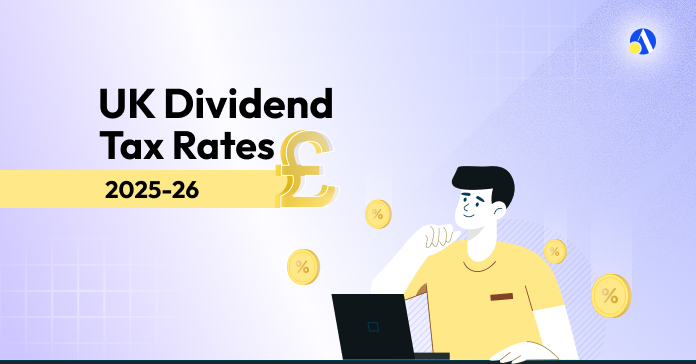For the 2025/26 tax year, the annual dividend allowance remains at £500. This means you can receive up to £500 in dividend income without paying any tax on it, irrespective of your other income.
Any dividend income exceeding this allowance will be taxed according to your income tax band.
Understanding dividend tax can be challenging, especially with recent changes to the allowance. How much dividend income can you receive tax-free? What are the tax rates for your income level? This guide will break down the 2025/26 dividend tax rates, explain how they apply to you, and clarify your tax obligations.
What Are Dividends?
Before we explore the rates, let's define what a dividend is.
A dividend is a payment a company distributes to its shareholders from its profits. For many directors of limited companies, taking a combination of a small salary and dividends is a tax-efficient way to draw income from the business.
For a more detailed explanation, read our beginner's guide to dividends here.
What are the dividend tax rates for 2025-26?
When your dividend income surpasses the £500 tax-free allowance, the tax you owe depends on your total income and its corresponding tax band. Remember, your total income includes your salary, dividend payments, and any other taxable earnings.
If you are wondering how much dividend can you pay yourself tax-free, Use the calculator here.
Dividend Tax in England, Wales & Northern Ireland
For the 2025/26 tax year, the dividend tax rates for England, Wales, and Northern Ireland are set as follows:
| Band | Taxable income | Tax rate | Dividend tax rate |
| Personal Allowance | Up to £12,570* | Up to £12,570* 0% | 0%** |
| Basic | £12,571 to £50,270 | 20% | 8.75% |
| Higher | £50,271 to £125,140 | 40% | 33.75% |
| Additional | More than £125,140 | 45% | 39.35% |
* Your Personal Allowance may be reduced if your adjusted net income is over £100,000.
** You won't pay any tax if your dividends fall within your £12,570 Personal Allowance and the £500 dividend allowance.
Dividend Tax in Scotland
While dividend tax rates are the same across the UK, Scotland has different income tax bands for employment and other non-savings income. However, for dividend income, Scottish taxpayers use the same tax bands as the rest of the UK.
| Band | Taxable income (UK-wide) | Scottish tax rate (on non-dividend income) | Dividend tax rate |
| Personal Allowance | Up to £12,570* | 0% | 0%** |
| Starter | £12,571 to £15,397 | 19% | 8.75% |
| Basic | £15,398 to £27,491 | 20% | 8.75% |
| Intermediate | £27,492 to £43,662 | 21% | 8.75% |
| Higher | £43,663 to £75,000 | 42% | 8.75% / 33.75% |
| Advanced | £75,001 to £125,140 | 45% | 33.75% |
| Top | More than £125,140 | 48% | 39.35% |
For Scottish taxpayers, dividend income is combined with other earnings to determine the correct dividend tax rate. For example, if your salary places you in the Scottish Intermediate band, but adding your dividends pushes your total income above the UK Higher Rate threshold (£50,271), that part of your dividends will be taxed at 33.75%.
To find out more about Scottish Income Tax Rates, read our guide here.
What is the tax threshold for 2025-26?
The main tax thresholds for 2025/26 remain unchanged. The tax-free Personal Allowance is set at £12,570, and the dividend allowance is £500. This means you’ll only pay tax on dividends if your dividend income exceeds £500 and your Personal Allowance has already been used by other income.
How much dividend can I pay myself tax-free?
How much dividend income you can receive tax-free depends on whether you have other sources of income.
- If you have no other income, you can receive up to £13,070 in dividends tax-free during the 2025/26 tax year. This total is a combination of your £12,570 Personal Allowance and the £500 dividend allowance.
- However, if you’re a business owner who also draws a salary that uses up your full Personal Allowance, you can only receive £500 in dividends before tax is due.
Are dividends taxed at 40%?
No, dividends are not taxed at the 40% income tax rate. They have their own specific tax rates which are determined by your income tax band.
- If your total income places you in the higher rate tax band (£50,271 to £125,140), any dividends you earn within this band are taxed at 33.75%.
- For additional rate taxpayers with an income over £125,140, the dividend tax rate is 39.35%. This is different from the 45% additional rate for income tax.
Optimise Your Dividend Tax with Debitam
Understanding the dividend tax rates for 2025/26 is key to managing your finances effectively. For business owners, structuring your income to be as tax-efficient as possible is essential to maximising take-home pay. With allowances shrinking, planning ahead is more important than ever.
At Debitam, we help small business owners navigate the complexities of tax. Our experts offer tailored advice on optimising your salary and dividends while staying compliant with tax regulations.
Get in touch with Debitam today to prepare your dividend strategy for the 2025/26 tax year.













